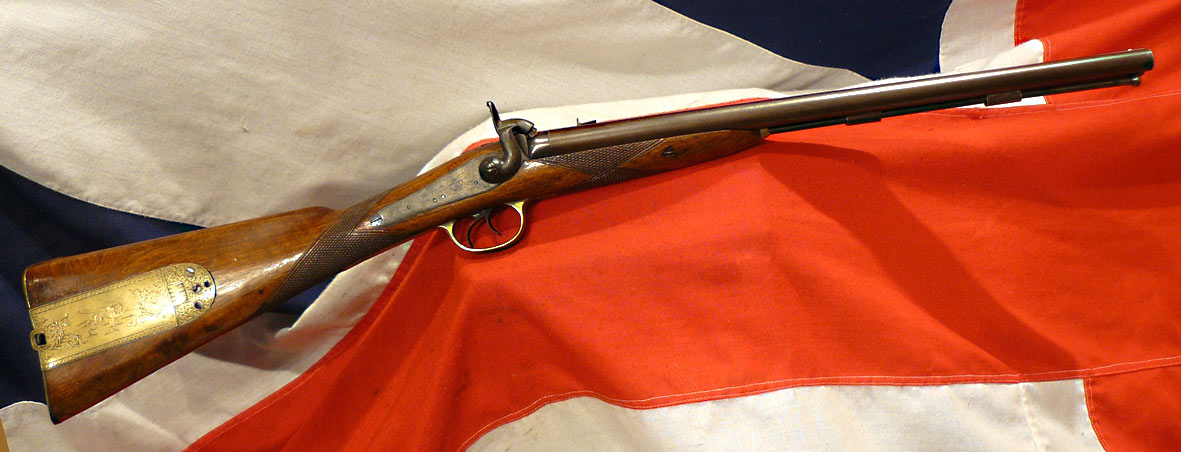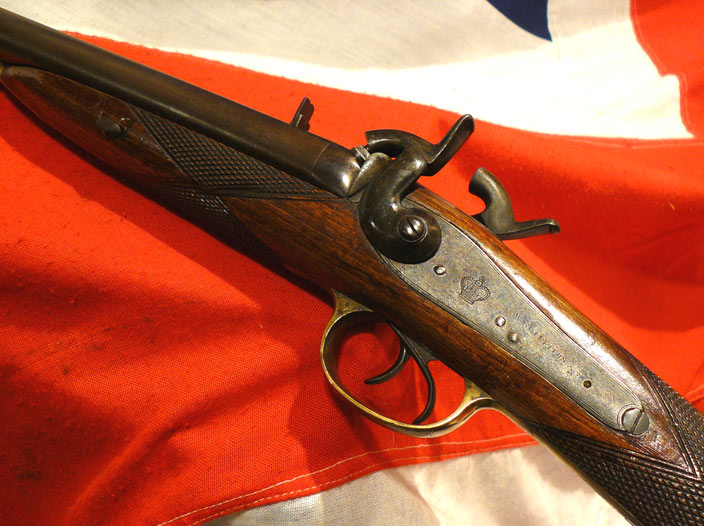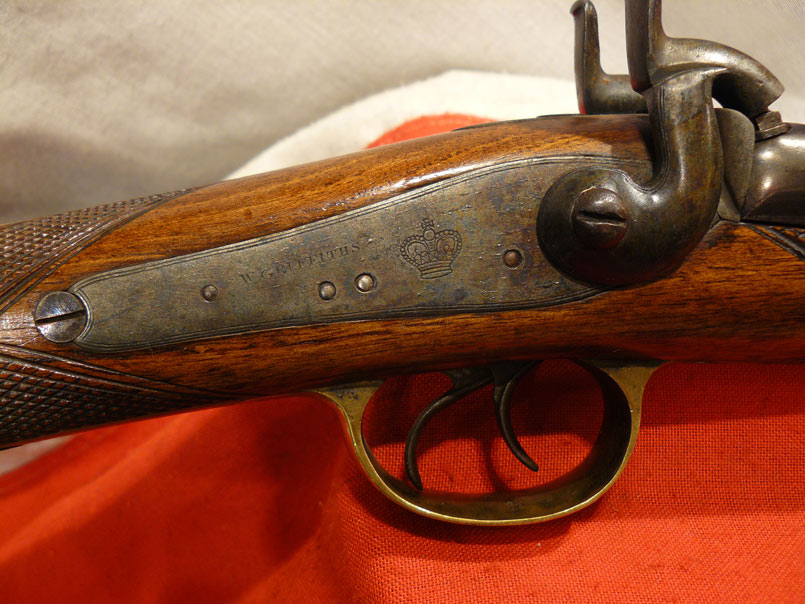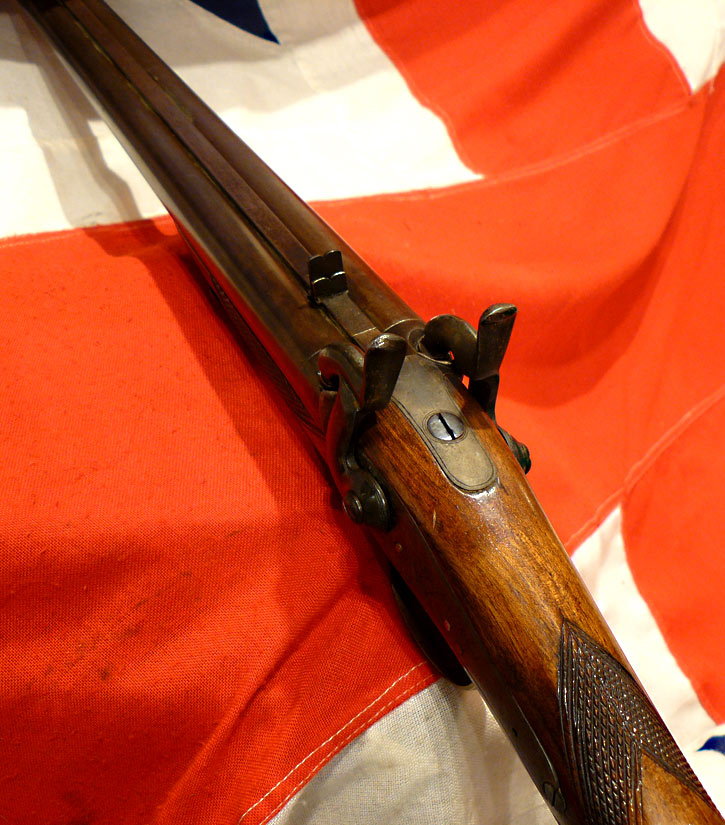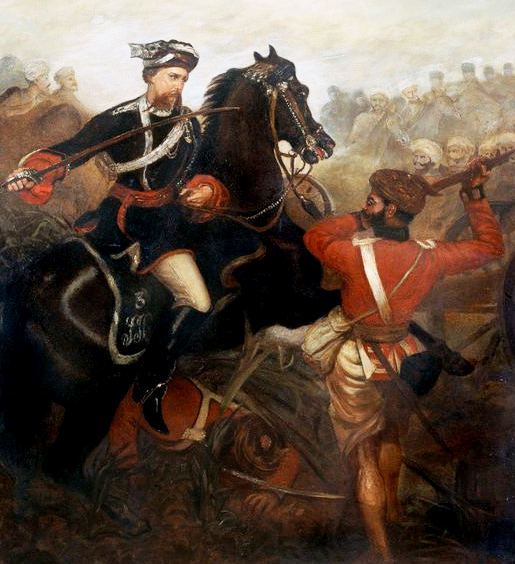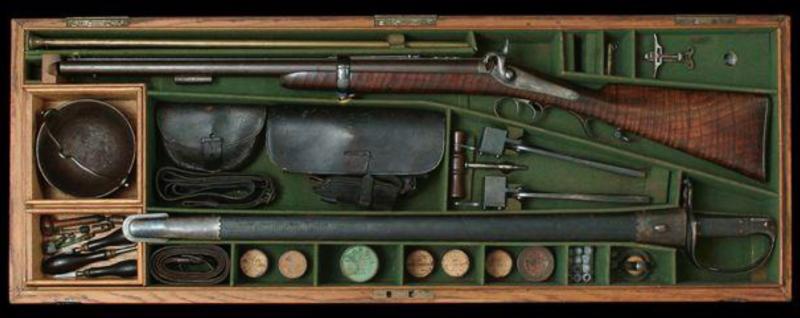A Fabulous & Most Rare British, Hand Made Griffiths ‘Jacob’s Double Barrel Rifle Carbine, From The Early British Raj. Period Bespoke Commissioned From Griffiths Circa 1848 For An Officer of Jacobs Horse
From the same officer that used in combat our Scind Horse officer's sword that arrived this week.
The gun is the very inspiration for the famous Military Jacob's Rifle, used by the Scinde Irregular Force, Jacob’s Rifles, in the early 1850's, and this was commissioned for an officer of the regiment.
Apparently experimental versions of the rifle were manufactured for Jacob by George H. Daw, and we are told, Griffiths, who (among others) later advertised these fabulous hand made bespoke rifles of Daws gun.
A writer of the period described shooting a rifle of this form:
“The recoil is by no means pleasant. Jacob recommended a powder charge of some 2 drams 68 grains of gunpowder! This rifle does not seem to have any advantages at sporting ranges; but for military purposes it has been strongly recommended. Especially in reference to the explosive shells which are used with it.the shells require a short stout barrel, and cannot be used with a long thin one, like the Enfield still, Enfield-style rifles were actually manufactured with Jacob rifling, and seemed relatively popular. For killing large animals, like the elephant or rhinoceros, they are particularly qualified; and I should strongly recommend elephant hunters to examine the merits of this rifle. This rifle was made to accompany the howdah pistol as the big game hunting rifle to be equally at home on foot, on horseback or while standing in a howdah on one's elephant. But also for perfect use in Indian irregular cavalry by gentlemen officers. The brass mounts are superbly engraved throughout, including a Bengal tiger and lion below mount Kilimanjaro, and profuse, highly accomplished decorative scrolling.
This is a finest gentleman's hand made double rifle, circa 1848, made by Griffiths of England, it is also bearing Queen Victoria's crown mark to both locks, which would further indicate government military service. By comparing the Jacob's Rifle by photograph, to this fine rifle alongside each other, one can easily see where the inspiration came from. This gun also bears influences from the design of the earlier British military Baker and contemporary Brunswick rifles, with a near identical patchbox arrangement to Jacobs rifles but rectangular.
The Jacob's rifle was designed by General Jacobs of the Honourable East India Co. who was so admired and respected by all who knew him, for his intelligence and skill of command, he had a city named after him, in modern day Pakistan, called Jacobabad. He had spent 25 years improving rifled firearms, carrying on experiments unrivalled even by public bodies. A range of 200 yards sufficed in cantonments, but at Jacobabad he had to go into the desert to set up butts at a range of 2000 yards. He went for a four grooved rifle and had numerous experimental guns manufactured in London by the leading gunsmith George Daw and completely at his expense. Jacob, like Joseph Whitworth, was renowned not only as a soldier but as a mathematician, and his rifle was as unconventional as its designer. Rather than using a small .45 caliber bore Jacob stayed with more conventional .57-58 caliber (Bill Adams theorizes that this would allow use of standard service ammo in a pinch). In any case his rifle used four deep grooves and a conical bullet with corresponding lugs. Though unusual the Jacob?s rifle, precision made in London by master gunsmiths like George Daw, quickly gained a reputation for accuracy at extended ranges. They appealed in in particular to wealthy aristocratic scientists like Lord Kelvin, who swore by his. Jacob wanted to build a cannon on the same pattern, but died early at age 45.
A few Jacob’s were used during the American Civil War, and those were privately owned, usually by men able to afford the best. There is one account of one of Berdan’s men using one (the chaplain, Lorenzo Barber), who kept one barrel of his double rifle loaded with buckshot and the other with ball.
Jacob's Rifles was a regiment founded by Brigadier John Jacob CB in 1858. Better known as the commandant of the Sind Horse and Jacob's Horse, and the founder of Jacobabad, the regiment of rifles he founded soon gained an excellent reputation. It became after partition part of the Pakistani Army, whereas Jacob's Horse was assigned to the Indian Army. A number of his relatives and descendants served in the Regiment, notably Field Marshal Sir Claud Jacob, Lieutenant-Colonel John Jacob and Brigadier Arthur Legrand Jacob, Claud's brother. As commander of the Scinde Irregular Horse, Jacob had become increasingly frustrated with the inferior weapons issued to his Indian cavalrymen. Being a wealthy man, he spent many years and much money on developing the perfect weapon for his 'sowars'. He eventually produced the rifle that bears his name. It could be sighted to 2000 yards (1 830m), and fire explosive bullets designed to destroy artillery limbers. It also sported a 30 inch (76,2cm) bayonet based on the Scottish claymore.
Jacob was an opinionated man who chose to ignore changing trends in firearm development, and he adopted a pattern of rifling that was both obsolete and troublesome. Nevertheless, his influence was such that during the Mutiny he was permitted to arm a new regiment with his design of carbine. It was named Jacob's Rifles.
Orders for the manufacture of the carbine and bayonet were placed in Britain, and all was set for its demonstration when Jacob died. In the hope the East India Company would honour the order, production continued for a little over a year. This gun is overall in super condition with excellent action. A most rare and highly desirable gun indeed, a super gentleman and officer's example.
We show in the gallery a photo of a most similar Jacob's military rifle in it's case with accessories to compare the two side by side, this is for comparison information only.
As with all our antique guns no license is required as they are all unrestricted antique collectables
Code: 20842
5750.00 GBP

